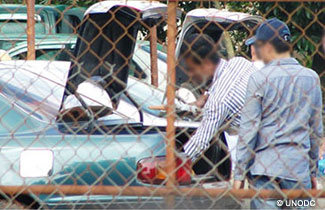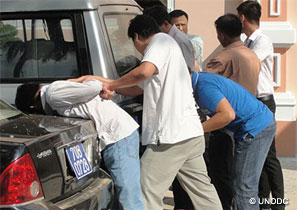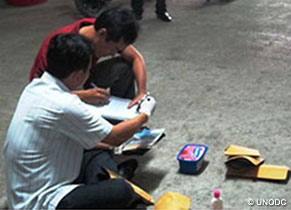In what would have appeared to any bystander the shooting of a scene for a James Bond movie, an arrest team quickly entered the scene and arrested a group of traffickers dealing in ivory carvings, rhino horn and heroin. The border officers in Cambodia had previously informed the police of their crossing checkpoint and the traffickers had been watched and followed as they met in a border town in Viet Nam to exchange the goods. Afterwards, evidence would be presented to a prosecutor and an investigation against the international criminal network involved in the smuggling would be set in motion.
 |
 |
|
| Officials acting as smugglers transfering rhino horns during a PATROL training programme for front-line border officers | Simulated arrest of two traffickers by Viet Nam border law enforcement officers in a UNODC PATROL training |
This was part of a scenario where undercover officers posed as traffickers in a series of anti-smuggling training courses for law enforcement officers working along and across borders of Cambodia and Viet Nam. The courses were conducted by the United Nations Office on Drugs and Crime (UNODC) from 1 to 12 October in Cambodia and from 29 October to 9 November in Viet Nam, as part of the UNODC PATROL (Partnership Against Transnational-crime through Regional Organized Law-enforcement) Programme.
The two-week events combined theory with live simulation of criminal activities, investigation and the collection of evidence. The main objectives were to enable border officers to tackle all transboundary criminal activities and to improve the effectiveness of investigations against crossborder crimes in Southeast Asia.
 |
 |
|
| Cambodia border officers conduct a simulated search of a car suspected of smuggling rhino horns | Evidence collection at the crime scene |
The training was delivered by a wide range of experts from all over the world, including people from immigration services, the police, Customs and forestry departements, and instructors from the Australian Federal Police and Department of Environment and Conservation, the Canadian Ministry of Environment, UNEP, UNODC and the Freeland Foundation.
The training events were supported by the Department of Immigration and Citizenship in Australia, the United Nations Environment Programme (UNEP) and the Secretariat of the Convention on International Trade in Endangered Species of Wild Flora and Fauna (CITES). CITES support was possible through funding from the European Commission as a part of CITES efforts to help build the capacity of national enforcement officials.
The training was delivered by a wide range of experts from all over the world, including people from immigration services, the police, Customs and forestry departements, and instructors from the Australian Federal Police and Department of Environment and Conservation, the Canadian Ministry of Environment, UNEP, UNODC and the Freeland Foundation.